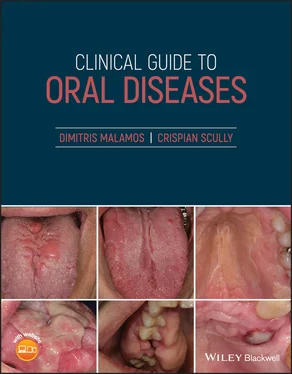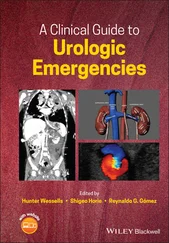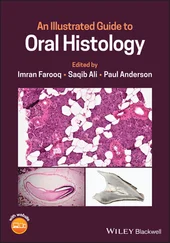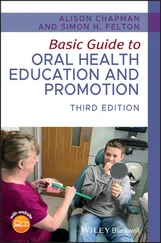1 ...8 9 10 12 13 14 ...29 Q1Which is the possible diagnosis?
1 Racial pigmentation
2 Hemosiderosis
3 Addison's disease
4 Melasma
5 Melanoma
Answers:
1 No
2 No
3 Addison's disease is the cause of the dark pigmentation of her skin and oral mucosa (especially on buccal mucosae) which was attributed to the increased stimulatory action of adrenocorticotropic hormone (ACTH) in the melanocytes, changing the color of melanin pigment to black or dark. This disease is characterized with adrenal insufficiency (secondary) due to the chronic use of steroids for the patient's asthma, and with stimulation and overproduction of pituitary hormones like ACTH. Low blood pressure, weight loss, muscle and joint pain, nausea, diarrhea and fainting during exercise and increased pigmentation are among the commonest manifestations of this disease.
Comments: Dark pigmented lesions are common and distinguished in diffuse and discrete ‐localized lesions. Diffuse pigmentation is common in dark skin patients (see racial pigmentation).in pregnancy (melasma) or in diseases per ce (Addison) or induced by drugs (hemosiderosis) Localized lesions are common and some of them like melanoma jeopardize patient’s life Their diagnosis is based on clinical characteristics like onset, location, type of discoloration location and progress. Racial pigmentation is usually noticed at an earlier age and not associated with general symptomatology. Hemosiderosis causes a similar discoloration but is not the cause as the patient did not have a history of blood dyscracias or overtaking of iron tablets, and her pigmentation remained unchanged. Melasma is also found in pregnant women, but restricted mainly on facial skin while melanoma is associated with satellite pigmented lesions and has a more aggressive clinical course.
Q2Addison's disease is characterized by:
1 Excess secretion of cortisol
2 Increased secretion of ACTH
3 Reduced secretion of aldosterone and cortisol
4 Reduced production of thyroid‐stimulating hormone (TSH)
5 Increased secretion of prolactin
Answers:
1 No
2 No
3 Reduced secretions of aldosterone and cortisol hormones are characteristic findings in Addison's disease, and caused either by disorders of the adrenal glands (primary) or inadequate secretion of ACTH from the pituitary gland (secondary).
4 No
5 Hyperprolactinemia is found in active phases of various autoimmune diseases such as systemic lupus erythematosus (SLE), rheumatoid arthritis, celiac disease, diabetes type 1 as well as Addison's disease.
Comments: An increased TSH, with or without low levels of thyroxine, occurs in patients with primary or secondary Addison's disease while increased cortisol and reduced ACTH levels are found in Cushing syndrome.
Q3Addison's disease is commonly part of syndromes such as:
1 Crouzon syndrome
2 McCune‐Albright syndrome
3 Griscelli syndrome
4 Peutz‐Jeghers syndrome
5 Autoimmune polyendocrine syndrome
Answers:
1 No
2 No
3 No
4 No
5 Autoimmune polyendocrine syndrome (PAS II) is characterized by a drop in production of several essential hormones, commonly found in patients with Addison's disease; hypo or hyperthyroidism, hypogonadism, and diabetes mellitus type I.
Comments: Skin or oral mucosa discolorations are characteristically seen in various syndromes apart from Addison's disease. Skin hyperpigmentation is also seen in Cushing syndrome and in other syndromes combined with acanthosis nigricans and early craniosynostosis (Crouzon syndrome) and with polyostotic fibrous dysplasia, café au lait skin pigmentations (McCune Albright syndrome). Skin hypopigmentation together with silver gray hair discoloration alone, or combined with brain or autoimmune dysfunctions are characteristics of Griscelli syndrome.

Figure 2.2a

Figure 2.2b
CO: A 58‐year‐old woman was referred for evaluation of an asymptomatic black spot on the lower alveolar mucosa opposite the right second molar.
HPC: This black lesion was first noticed by her dentist two days ago when the woman visited him to relieve her severe throbbing pain which had arisen from her broken second molar.
HPC: Her medical history was clear from any serious diseases apart from allergic rhinitis which was treated with anti‐histamine tablets. Her recent dental history revealed an extraction of her lower right third molar that had been heavily restored with amalgam.
OE: An isolated, flat black‐gray lesion was seen on the alveolar mucosa covering her previously extracted lower right wisdom tooth. The lesion was asymptomatic, soft in palpation with irregular margins (max dimension of 1.6 cm) and not associated with similar skin and other mucosae lesions or general symptomatology and lymphadenopathy (local or systemic) ( Figure 2.2a).The tooth next to the lesion also had an old broken filling with caries underneath causing severe pain. An intra‐oral radiograph revealed a radiopaque material with the healing socket of the extracted molar ( Figure 2.2b).
Q1What is the possible diagnosis?
1 Amalgam tattoo
2 Melanoma
3 Cosmetic tattoo
4 Metal poisoning
5 Pigmented nevus
Answers:
1 Amalgam tattoo is the answer. Amalgam tattoo is the most common exogenous material implanted in the soft tissues of alveolar mucosae, buccal mucosae, gingivae, floor of the mouth, palate, or tongue. It appears as a solitary or multiple, flat black to gray or even blue discrete asymptomatic discoloration, thus causing the patient concern and often being misdiagnosed as melanoma.
2 No
3 No
4 No
5 No
Comments: Localized pigment lesions are common and induced by accumulations of melanine producing cells (macules) benign neoplasmatic cells (nevi) or malignant cell s(melanoma) or even external dyes used for cosmetic tatoos Pigmented nevus has a similar appearance as amalgam tattoo, but has a longer duration with no history of trauma or teeth with heavy amalgam restorations, or even having undergone surgery (apicectomy/extractions). Melanomas have more aggressive clinical appearance, satellite lesions in the skin or oral mucosa, and lymphadenopathy and early distant metastases. Cosmetic tattoos are usually done in visible parts of mouth and skin while poisoning with metals appears as an extensive discoloration of the gingivae and other parts of the human body associated with various toxicity symptoms.
Q2The diagnosis of this lesion is based mainly on:
1 History
2 Clinical characteristics
3 Radiographic findings
4 Biopsy results
5 Oral photography
Answers:
1 History of previous extraction or renewing of old amalgam fillings by high speed drills or rotary instruments confirms the clinical suspicion of deposition of amalgam metallic particles into adjacent gingivae or other parts of the oral mucosa.
2 The clinical examination together with the previous dental records of old amalgam fillings are useful in the diagnosis of the majority of amalgam tattoos.
3 Intra‐oral X‐rays reveal radiopaque material only if it is adequate in size.
Читать дальше














